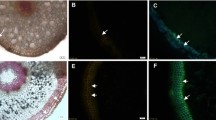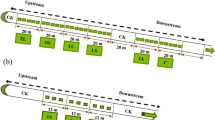Abstract
Bauxite residue disposal areas (BRDAs) are physically degraded and hostile to plant growth. Nevertheless, natural plant colonization was observed in an abandoned BRDA in Central China. The pioneer plant species at the disposal area were identified, whilst distribution characteristics of salt ions such as Na+, K+, and Ca2+ in plant tissues and rhizosphere residues were investigated. The mean concentration of exchangeable Na+ in the rhizosphere soils was 19.5 cmol/kg, which suggested that these pioneer plants had relatively high salinity resistance. Sodium content varied from 0.84 cmol/kg (Digitaria sanguinalis) to 39.7 cmol/kg (Kochia scoparia), whilst K to Na ratio varied from 0.71 (Myricaria bracteata) to 32.39 (Digitaria sanguinalis) in the shoots, which demonstrated that the salinity tolerance mechanisms of these pioneer species differed significantly. Accumulation factors of Na+ in local plant species ranged from 0.04 (D. sanguinalis) to 3.29 (M. bracteata), whilst the translocation factor varied from 0.13 (D. sanguinalis) to 2.92 (M. bracteata). The results suggested that four pioneer plant species including K. scoparia, M. bracteate, Cynodon dactylon and D. sanguinalis could be suitable for revegetation at other disposal areas.
摘要
盐分含量高是影响赤泥堆场植物生长的主要限制因子之一。通过对一个20 多年的赤泥堆场开 展生态调查,研究了先锋植物盐分积累及分布特性。结果发现:赤泥堆场出现14 种先锋植物;根系 土Na+ 平均含量为19.5 cmol/kg,这表明先锋植物具有较高的盐耐性;植物地上部分Na+含量差异明 显,马唐地上部Na+ 含量仅0.84 cmol/kg,扫帚苗地上部Na+ 含量高达39.7cmol/kg;马唐Na+迁移系 数为0.13,水柏枝的Na+迁移系数高达2.92;扫帚苗和水柏枝的Na 富集系数为2.66 和3.29;狗牙根 和马唐的Na+ 积累系数分别为0.07 和0.04;扫帚苗、水柏枝、狗牙根和马唐均可作为赤泥堆场植被 重建的先锋植物。研究结果为赤泥土壤化和堆场生态重建提供了科学参考。
Similar content being viewed by others
References
SMART D, CALLERY S, COURTNEY R. The potential for waste-derived materials to form soil covers for the restoration of mine tailings in Ireland [J]. Land Degradation & Development, 2016, 27: 542–549. DOI:10.1002/ldr.2465.
MENDEZ M O, MAIER R M. Phytostabilization of mine tailings in arid and semiarid environments— An emerging remediation technology [J]. Environmental Health Perspectives, 2008, 116: 278–283. DOI:10.1289/ehp.10608.
KONG Xiang-feng, GUO Ying, XUE Sheng-guo, HARTLEY W, WU Chuan, YE Yu, CHENG Qin. Natural evolution of alkaline characteristics in bauxite residue [J]. Journal of Cleaner Production, 2017, 143: 224–230. DOI: 10.1016/j.jclepro. 2016. 12. 125.
GR F M, KLAUBER C. Bauxite residue issues: IV. Old obstacles and new pathways for in situ residue bioremediation [J]. Hydrometallurgy, 2011, 108: 46–59. DOI: 10.1016/j.hydromet. 2011. 02. 005.
XUE Sheng-guo, ZHU Feng, KONG Xiang-feng, WU Chuan, HUANG Ling, HUANG Nan, WILLIAM H. A review of the characterization and revegetation of bauxite residues (red mud) [J]. Environmental Science and Pollution Research, 2016, 23: 1120–1132. DOI:10.1007/s11356-015-4558-8.
POWER G., GR FE M, KLAUBER C. Bauxite residue issues: I. Current management, disposal and storage practices [J]. Hydrometallurgy, 2011, 108: 33–45. DOI: 10.1016/j.hydromet.2011.02.006.
XUE Sheng-guo, KONG Xiang-feng, ZHU Feng, HARTLEY W, LI Xiao-fei, LI Yi-wei. Proposal for management and alkalinity transformation of bauxite residue in China [J]. Environmental Science and Pollution Research, 2016, 23(13): 12822–12834. DOI: 10.1007/s11356-016-6478–7.
JONES B E H, HAYNES R J. Bauxite processing residue: A critical review of its formation, properties, storage, and revegetation [J]. Critical Reviews in Environmental Science and Technology, 2011, 41: 271–315. DOI:10.1080/10643380902800000.
XUE Sheng-guo, YE Yu, ZHU Feng, WANG Qiong, JIANG Jun, HARTLEY W. Changes in distribution and microstructure of bauxite residue aggregates following amendments addition [J]. Journal of Environmental Sciences, 2019, 78: 276–286, DOI: 10.1016/j.jes.2018.10.010.
SANTINI T C, FEY M V. Spontaneous vegetation encroachment upon bauxite residue (Red Mud) as an indicator and facilitator of in situ remediation processes [J]. Environmental Science & Technology, 2013, 47: 12089–12096. DOI: 10.1021/es402924g.
ZHU Feng, XUE Sheng-guo, HARTLEY W, HUANG Ling, WU Chuan, LI Xiao-bin. Novel predictors of soil genesis following natural weathering processes of bauxite residues [J]. Environmental Science & Pollution Research, 2015, 23: 1–8. DOI: 10.1007/s11356-015-5537-9.
PILON-SMITS E. Phytoremediation [J]. Annu Rev Plant Biol, 2005, 56: 15–39. DOI: 10.1146/annurev.arplant.56. 032604.144214.
ZHU Feng, LI Yu-hua, XUE Sheng-guo, HARTLEY W, WU Hao. Effects of iron-aluminium oxides and organic carbon on aggregate stability of bauxite residues [J]. Environmental Science and Pollution Research, 2016, 23: 9073–9081. DOI:10. 1007/s11356-016-6172-9.
XIAO Guang, LI Ting, ZHANG Xi, YU Hai, HUANG Hua, GUPTA D K. Uptake and accumulation of phosphorus by dominant plant species growing in a phosphorus mining area [J]. Journal of Hazardous Materials, 2009, 171: 542–550. DOI: 10.1016/j.jhazmat.2009. 06. 034.
RABHI M, FERCHICHI S, JOUINI J, HAMROUNI M H, KOYRO H W, RANIERI A, ABDELLY C, SMAOUI A. Phytodesalination of a salt-affected soil with the halophyte Sesuvium portulacastrum L. to arrange in advance the requirements for the successful growth of a glycophytic crop [J]. Bioresource Technology, 2010, 101: 6822–6828. DOI: 10.1016/j. biortech. 2010.03.097.
ZHANG Xing, XIA Han, LI Zhi, ZHUANG Ping, GAO Bo. Potential of four forage grasses in remediation of Cd and Zn contaminated soils [J]. Bioresource Technology, 2010, 101: 2063–2066. DOI: 10.1016/j.biortech.2009.11.065.
RAVINDRAN K C, VENKATESAN K, BALAKRISHNAN V, CHELLAPPAN K P, BALASUBRAMANIAN T. Restoration of saline land by halophytes for Indian soils [J]. Soil Biology and Biochemistry, 2007, 39: 2661–2664. DOI: 10.1016 /j.soilbio.2007.02.005.
GR FE M, POWER G, KLAUBER C. Bauxite residue issues: III. Alkalinity and associated chemistry [J]. Hydrometallurgy, 2011, 108: 60–79. DOI: 10.1016 /j.hydromet.2011.02.004.
ZHU Feng, LIAO Jia-xin, XUE Sheng-guo, HARTLEY W, ZOU Qi, WU Hao. Evaluation of aggregate microstructures following natural regeneration in bauxite residue as characterized by synchrotron-based X-ray micro-computed tomography [J]. Science of the Total Environment, 2016, 573: 155–163. DOI: 10.1016 /j.scitotenv.2016.08.108.
ZHU Feng, CHENG Qing, XUE Sheng-guo, LI Chu-xuan, HARTLEY W, WU Chuan. TIAN Tao. Influence of natural regeneration on fractal features of residue microaggregates in bauxite residue disposal areas [J]. Land Degradation and Development, 2018, 29(1): 138–149. DOI: 10.1002/ldr.2848.
BANNING N C, SAWADA Y, PHILLIPS I R, MURPHY D V. Amendment of bauxite residue sand can alleviate constraints to plant establishment and nutrient cycling capacity in a water-limited environment [J]. Ecological Engineering, 2014, 62: 179–187. DOI: 10.1016/j.ecoleng. 2013. 10. 034.
ZHU Feng, HOU Jing, XUE Sheng-guo, WU Chuan, WANG Qiong, HARTLEY W. Vermicompost and gypsum amendments improve aggregate formation in bauxite residue [J]. Land Degradation & Development, 2017, 28: 2109–2120. DOI: 10.1002/ldr.2737.
COURTNEY R, MULLEN G, HARRINGTON T. An evaluation of revegetation success on bauxite residue [J]. Restoration Ecology, 2009, 17: 350–358. DOI: 10.1111/j.1526-100x. 2008. 00375.x.
XUE Sheng-guo, LI Meng, JIANG Jun, MILLAR G J, LI Chu-xuan, KONG Xiang. Phosphogypsum stabilization of bauxite residue: Conversion of its alkaline characteristics [J]. Journal of Environmental Sciences, 2019, 77: 1–10. DOI: 10.1016/j.jes.2018.05.016.
KONG Xiang-feng, TIAN Tao, XUE Sheng-guo, HARTLEY W, HUANG Long, WU Chuan, LI Chu. Development of alkaline electrochemical characteristics demonstrates soil formation in bauxite residue undergoing natural rehabilitation [J]. Land Degradation and Development, 2018, 29(1): 58–67. DOI: 10.1002/ldr.2836.
COURTNEY R G., JORDAN S N., HARRINGTON T. Physico-chemical changes in bauxite residue following application of spent mushroom compost and gypsum [J]. Land Degradation & Development, 2009, 20: 572–581. DOI: 10.1002/ldr.926.
FELLET G, MARMIROLI M, MARCHIOL L. Elements uptake by metal accumulator species grown on mine tailings amended with three types of biochar [J]. The Science of the Total Environment, 2014, 468–469: 598–608. DOI: 10.1016/j.scitotenv. 2013.08.072.
CHANDRA R, YADAV S, YADAV S. Phytoextraction potential of heavy metals by native wetland plants growing on chlorolignin containing sludge of pulp and paper industry [J]. Ecological Engineering, 2017, 98: 134–145.
LIU Yue, YAN Xiao, JIAO zhen-fa. Effects of climate and eco-environment conditions on four-majorhuai-medicine growth in Jiaozuo, Henan [J]. Meteorological, 2007, 33: 105–110.
MUNNS R, TESTER M. Mechanisms of salinity tolerance [J]. Annu Rev Plant Biol, 2008, 59: 651–681. DOI: 10.1146/annurev.arplant.59.032607.092911.
ZHU Feng, LI Xiao-fei, XUE Sheng-guo, HARTLEY W, WU Chuan, HAN Fu. Natural plant colonization improves the physical condition of bauxite residue over time [J]. Environmental Science and Pollution Research, 2016, 23(22): 22897–22905. DOI: 10.1007/s11356-016-7508-1.
FLOWERS T J, COLMER T D. Salinity tolerance in halophytes [J]. New Phytologist, 2008, 179: 945–963. DOI: 10.1111/j.1469-8137.2008.02531.x.
DEINLEIN U, STEPHAN A B, HORIE T, LUO W, XU G, SCHROEDER J I. Plant salt-tolerance mechanisms [J]. Trends Plant Sci., 2014, 19: 371–379. DOI: 10.1016/j.tplants.2014.02. 001.
WOODARD H J, HOSSNER L, BUSH J. Ameliorating caustic properties of aluminum extraction residue to establish a vegetative cover [J]. Journal of Environmental Science and Health Part A-Toxic/Hazardous Substances & Environmental Engineering, 2008, 43: 1157–1166. DOI: 10.1080/10934520802171659.
KONG Xiang-feng, LI Meng, XUE Sheng-guo, HARTLEY W, CHEN Cheng, WU Chuan, LI Xiao-fei, LI Yi-wei. Acid transformation of bauxite residue: Conversion of its alkaline characteristics [J]. Journal of Hazardous Materials, 2017, 324: 382–390. DOI: 10.1016/j.jhazmat. 2016.10.073.
CHEN Z, NEWMAN I M, MENDHAM N, ZHANG G, SHABALA S. Screening plants for salt tolerance by measuring K+ flux: A case study for barley [J]. Plant Cell & Environment, 2005, 28: 1230–1246. DOI: 10.1111/j.1365-3040.2005.01364.x.
SHABALA S, CUIN T A. Potassium transport and plant salt tolerance [J]. Physiologia Plantarum, 2008, 133: 651–669. DOI: 10.1111/j.1399-3054. 2007. 01008.x.
WEI Wen, BILSBORROW P E, HOOLEY P, FINCHAM DARON A, LOMBI E. Salinity induced differences in growth, ion distribution and partitioning in barley between the cultivar Maythorpe and its derived mutant Golden Promise [J]. Plant and Soil, 2003, 250: 183–191. DOI: 10.1023/A:1022832107999.
CHERIAN S, REDDY M P. Evaluation of NaCl tolerance in the callus cultures of suaeda nudiflora Moq [J]. Biologia Plantarum, 2003, 46: 193–198. DOI: 10.1023/A: 1022838224429.
Author information
Authors and Affiliations
Corresponding author
Additional information
Foundation item: Project(41877511) supported by the National Natural Science Foundation of China
Rights and permissions
About this article
Cite this article
Huang, N., Tang, L., Zhu, F. et al. Salt ions accumulation and distribution characteristics of pioneer plant species at a bauxite residue disposal area, China. J. Cent. South Univ. 26, 323–330 (2019). https://doi.org/10.1007/s11771-019-4004-z
Received:
Accepted:
Published:
Issue Date:
DOI: https://doi.org/10.1007/s11771-019-4004-z




